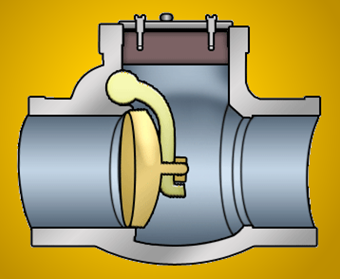Check Valves: The Most Important Valves in Your Process System
Check valves, as critical as they are for flow system performance, often don’t receive the respect they are due, said Arie Bregman, vice president and general manager, DFT, Inc., in a recent VMA presentation.
#gate-globe-check #VMAnews #automation
TYPES OF CHECK VALVES AND ACCESSORIES
Check valves come in many styles, using different mechanisms to block reverse flow, including disks, balls, pistons, and other forms. The flow may be straight through, angled or lift style. Each type of check valve has its advantages. Swing type check valves may allow cleaning or inspecting the pipeline with a pig unit that passes through the pipe. Others work best with vertical flows. Some are in-line repairable. Some tolerate flows containing solids or fibrous material.
Accessories can fine-tune a valve’s performance. Various combinations of levers and weights, springs, air cushions or oil dashpots can help control a valve’s closing rate to match the application and prevent valve slam and water hammer problems. Other accessories, such as position indicators, provide operational information. In many applications, it may be a good idea to include a backwash device, Bregman said, to clear out any debris that accumulates at the bottom of the valve.
THE RIGHT VALVE FOR THE JOB
Since the flow of the fluid opens the check valve, knowledge of the flow and its characteristics is critical. Is the fluid a liquid, gas or multiphase—with solids in a liquid stream or liquid in a gas stream? What will be the normal volumetric flow rate? Is the flow horizontal, vertical? Up or down? What will be the temperature and pressure of the flow? What are the physical properties of the flow, such as density and viscosity? What are the chemical properties of the flow, such as its pH and vapor pressure? Is it corrosive? Is it abrasive?
These flow characteristics determine which styles of check valve would do the job, and any special material requirements for the valve and trim components.
SIZING A CHECK VALVE
“To be reliable, a check valve needs to be properly sized,” Bregman said. Sometimes people assume that the pipeline size determines the valve size. This is not so, especially with check valves.
For stable performance and long life, check valves must be properly sized for the flow they will handle. They need to experience sufficient flow to keep them fully open under normal flow conditions. “Always do the sizing calculations,” Bregman said.
To keep a check valve fully open typically requires a fluid velocity of 10 to 12 feet per second, Bregman said, for liquids such as water. To start the opening of the check valve, the “cracking pressure,” requires about 4 to 8 feet/second. The pressure drop to keep the check valve open is generally two to five times the cracking pressure.
What happens if a check valve is the wrong size?
An oversized check valve results in a low flow rate that will not keep the valve consistently open. This causes instability, where the valve can chatter or flutter. This, in turn, causes premature mechanical wear of the valve and likely additional maintenance costs due to more frequent valve/trim replacement, as well as additional system shutdowns to repair or replace the check valve.
An undersized check valve results in a too-high flow rate through the valve resulting in unnecessarily high pressure loss in the system. It also may create excessive turbulence in the flow, which can cause valve instability and increased mechanical wear, leading to higher maintenance costs. Also, the higher flow rate through an undersized valve may increase erosive wear inside the valve.
Use the appropriate engineering formulas for determining proper valve size, Bregman said.
UNDER PRESSURE
The valve coefficient, Cv, for a valve is used to calculate pressure loss. For water, Cv is the flow in gpm (gal/min) at a pressure differential of 1 psi (lb/square inch) In SI units, Kv is a similar flow coefficient: for water, cubic meters/hour at a pressure difference of 1 bar.
A higher Cv means lower pressure loss for a given flow rate. In other kinds of valves, higher Cv is usually desirable; not so with check valves, which require a different approach. For check valves, the critical factor is having sufficient flow to keep the valve open at the normal system flow rate. When properly sized, they require a corresponding pressure drop to operate effectively. As part of the check valve selection process, “you need to know the minimum flow rate or pressure drop required to maintain the valve in the full open position,” Bregman said.
APPLICATION CONSIDERATIONS
Even a properly sized check valve may experience instability when handling turbulent flow due to a pump, elbow or other flow disturbance upstream. It is good practice to allow a length of straight pipe upstream of the valve to allow turbulence to dissipate, if space is available. Typically, a length of 10 pipe diameters is sufficient.
Check valves play an important part in protecting other components in flow systems. To do its job, each check valve needs to be a type appropriate to the application and needs to be sized correctly so it stays fully open with the normal operating flow. Correctly selected and sized, check valves can have a long, trouble-free working life.
VMA offers webinars on a variety of topics. For the latest webinar schedule, go to VMA.org/Webinars.
Barbara Donohue is web editor at VALVE Magazine.
Images courtesy DFT, Inc.
RELATED CONTENT
-
An Introduction to Axial Flow Check Valves
Check valves are self-actualizing devices that respond to both pressure and flow changes in a piping system.
-
Knifegate Valve Maintenance and Repair
Knife gate valves are used to provide isolation in various applications including oil sands slurries, pulp stock, waste water and power generation.
-
Stop Check Valves
Stop check valves are vital to several industries to protect boilers and other equipment.













 Unloading large gate valve.jpg;maxWidth=214)